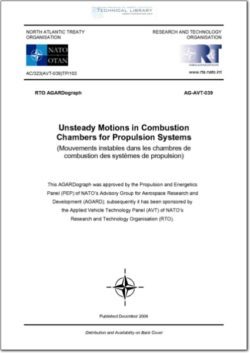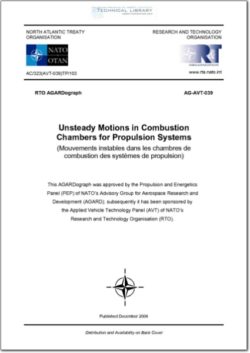AGARD-RTO-AG-AVT-039

- Version
- 285 Downloads
- 12.62 MB File Size
- 1 File Count
- April 28, 2016 Create Date
- April 28, 2016 Last Updated
Unsteady Motions in Combustion Chambers for Propulsion Systems

Phenomena referred to generally as combustion instabilities are fundamentally related to the stability of
motions in a combustion chamber. Their existence is normally inferred from observations of well defined
oscillations of pressure or structural distortions. Instabilities of combustion processes themselves are rarely
contributing factors7 the chief exceptions being possible intrinsic instabilities of solid propellants, and the
weakening of flame stabilization mechanisms near the lean operating limits of gaseous and liquid fueled
systems. Broadly, then, the appearance of a combustion instability is due to a loss of stability of the
composite dynamical system comprising the combustion processes and the chamber itself, containing the
medium which supports waves associated with the unstable motions.
Combustion instabilities have been found in all types of systems. The reason is simple and fundamental:
In a combustor, by design the combustion processes generate high power densities under conditions when
the losses of energy are small. Only weak coupling between fluctuations of the combustion power and the
flow of the medium is sufficient to produce undesirable fluctuations of pressure and kinetic energy in the
flow. Mainly three characteristics of a system influence its dynamical behavior: the physical state in which
reactants are introduced (solid, liquid, gas); the geometry of the system; and the specific mechanism causing
the instabilities to occur. It is therefore possible to construct a general analytical framework sufficiently
comprehensive to capture most, if not all, of the main features of instabilities in any combustion system.
One purpose of this book is to describe an approach that has been applied successfully to a broad range of
problems arising in laboratory devices and in full-scale systems.
The approach follows a well-travelled path which consists essentially in constructing reduced-order mod-
els of dynamical behavior by first applying a method of spatial averaging. Formally the dynamics of the
continuous flow system having an infinite number of degrees of freedom is represented by the dynamics of a
system of coupled nonlinear oscillators in one—to—one correspondence with the natural acoustic modes of the
combustor in question. Long understood from experience in several fields, the idea leads to an analytical
framework that is easily applied to laboratory test devices, sub-scale tests and to full-scale combustion sys-
tems of all sorts. Representation constructed of acoustic modes is not so restrictive as first appears, neither
in respect to the perturbing processes, nor in respect to linearity. So long as the amplitudes are not ‘too’
great, quite general motions can be synthesized. For realistic applications, the greatest difiiculties arise in
modeling the dominant physical and chemical processes; and in determining certain material and dynamical
properties.
| File | Action |
|---|---|
| AGARD-RTO-AG-AVT-039 Unsteady Motions in Combustion Chambers for Propulsion Systems .pdf | Download |

Comment On This Post